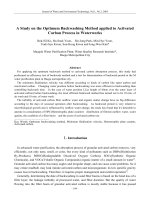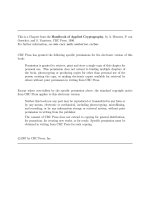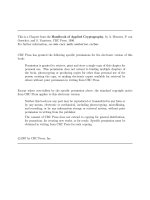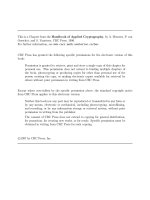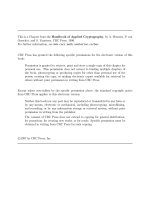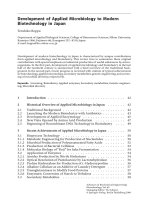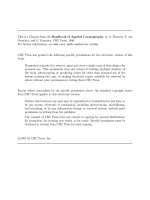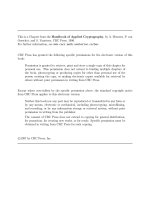Applied photochemistry
Bạn đang xem bản rút gọn của tài liệu. Xem và tải ngay bản đầy đủ của tài liệu tại đây (11.97 MB, 619 trang )
Rachel C. Evans
Peter Douglas
Hugh D. Burrows Editors
Applied
Photochemistry
Applied Photochemistry
Rachel C. Evans Peter Douglas
Hugh D. Burrows
•
Editors
Applied Photochemistry
123
Editors
Rachel C. Evans
School of Chemistry, Trinity College
The University of Dublin
Dublin
Ireland
Hugh D. Burrows
Department of Chemistry
University of Coimbra
Coimbra
Portugal
Peter Douglas
Chemistry Group, College of Engineering
Swansea University
Swansea
UK
ISBN 978-90-481-3829-6
DOI 10.1007/978-90-481-3830-2
ISBN 978-90-481-3830-2
(eBook)
Springer Dordrecht Heidelberg New York London
Library of Congress Control Number: 2013931951
Ó Springer Science+Business Media Dordrecht 2013
This work is subject to copyright. All rights are reserved by the Publisher, whether the whole or part of
the material is concerned, specifically the rights of translation, reprinting, reuse of illustrations,
recitation, broadcasting, reproduction on microfilms or in any other physical way, and transmission or
information storage and retrieval, electronic adaptation, computer software, or by similar or dissimilar
methodology now known or hereafter developed. Exempted from this legal reservation are brief
excerpts in connection with reviews or scholarly analysis or material supplied specifically for the
purpose of being entered and executed on a computer system, for exclusive use by the purchaser of the
work. Duplication of this publication or parts thereof is permitted only under the provisions of
the Copyright Law of the Publisher’s location, in its current version, and permission for use must
always be obtained from Springer. Permissions for use may be obtained through RightsLink at the
Copyright Clearance Center. Violations are liable to prosecution under the respective Copyright Law.
The use of general descriptive names, registered names, trademarks, service marks, etc. in this
publication does not imply, even in the absence of a specific statement, that such names are exempt
from the relevant protective laws and regulations and therefore free for general use.
While the advice and information in this book are believed to be true and accurate at the date of
publication, neither the authors nor the editors nor the publisher can accept any legal responsibility for
any errors or omissions that may be made. The publisher makes no warranty, express or implied, with
respect to the material contained herein.
Printed on acid-free paper
Springer is part of Springer Science+Business Media (www.springer.com)
Preface
Photochemistry is a mature science. We now have a fairly detailed understanding
of the physical and chemical pathways involving production and deactivation of
excited states and photochemistry is currently used in a broad range of applications
ranging from transistor chip production using photolithography, through advanced
synthetic methodologies, sensing, and imaging, to clinical use in the phototherapy
of jaundice and photodynamic therapy of cancer. In addition, sunlight is the only
fully sustainable energy source that is capable of meeting all the earth’s requirements for the foreseeable future, and photochemistry plays a crucial role in the
interconversion of solar energy into electricity or chemical fuels. However,
although a number of excellent books are available on the scientific aspects of
photochemistry, and individual monographs are available on specific applications,
there is a lack of a general text on the applications of photochemistry. Our aim
with Applied Photochemistry is to remedy this with contributions from specialists
involved in applications of photochemistry in the key areas of chemistry, physics,
medicine and engineering. We feel that this book will be useful for students and
researchers in chemical, physical, biological, environmental and atmospheric
sciences, as well as those in engineering and biomedical research, who are
interested in applying photochemistry to their work. The chapters are self-contained, so the text can either be read as a whole or individual chapters can be used
to rapidly obtain information on specific areas. Topics are treated in sufficient
depth, wit references to appropriate current literature, to lead the reader to discover
the state of the art in each topic.
The first Chapter provides a comprehensive background on the foundations of
photochemistry, which will be useful for non-specialists. Chapters 2 and 3 cover
the most important aspects of organic and inorganic photochemistry, from both
synthetic and mechanistic viewpoints. Applications in materials science are discussed in Chap. 4, and range from colorants, pigments and dyes through light
emitters for use in illumination and displays to photochromic materials. Chapter 5
presents a comprehensive description of the main photochemical processes
occurring in the atmosphere, including those leading to air pollution. Water and
waste pollution are discussed in Chap. 6 from the viewpoint of direct and catalytic
photochemical processes which can be used for treatment and remediation. The
v
vi
Preface
conversion of sunlight into electrical energy through photovoltaic systems or
chemical fuels by mimicking the water splitting and carbon dioxide reduction of
photosynthesis is treated in detail in Chap. 7. Many of the processes involved in
biomedical applications of photochemistry involve free radicals and reactive
oxygen species, and Chap. 8 discusses these and provides a description of the
experimental methods used for their study. Medical aspects of photochemistry are
treated in Chap. 9 and 10 in terms of the application of light in various clinical
treatments in the area of photomedicine, including the important topic of photodynamic therapy, and the way that photochemical diagnostics are proving valuable
in a wide variety of clinical assays. Chapter 10 also shows the important role of
photochemistry in the developing area of nanomedicine. Chapter 11 provides a
detailed description of photochemical processes in imaging, describing the historical development of ‘silver halide’ and other photographic processes and
extending these to non-silver photographic and electrophotographic processes.
Optical sensors and probes are discussed in Chap. 12 in terms of the fundamental
principles behind optical sensing, the different types of optical probes available
and the way to design appropriate devices for studying single or multiple analytes.
Chapter 13 shows the important roles that photoactive polymers and photolithography play in the fabrication of advanced semiconductor devices. The last two
chapters describe the basic instrumentation, equipment and requirements necessary
for setting up a laboratory dedicated to photochemical research and the experimental methods involved in the characterisation of excited states.
We are indebted to all of the authors for their excellent contributions to this
volume. We would also like to acknowledge our many teachers, colleagues, coworkers and students for their efforts in showing that the interaction of light with
molecules is of both great academic interest and very real practical application.
Finally, we would like to thank Ilaria Tassistro and Sonja Ojo from the Springer
UK Chemistry Editorial Team for their patience and support.
Rachel C. Evans
Peter Douglas
Hugh D. Burrows
Contents
1
Foundations of Photochemistry: A Background
on the Interaction Between Light and Molecules . . . . . . . . . . . . .
Peter Douglas, Hugh D. Burrows and Rachel C. Evans
1
2
Photochemical Synthesis . . . . . . . . . . . . . . . . . . . . . . . . . . . . . . .
Valentina Dichiarante and Angelo Albini
89
3
Inorganic Photochemistry . . . . . . . . . . . . . . . . . . . . . . . . . . . . . .
Julia A. Weinstein
105
4
Photochemical Materials: Absorbers, Emitters, Displays,
Sensitisers, Acceptors, Traps and Photochromics . . . . . . . . . . . . .
Matthew L. Davies, Peter Douglas, Rachel C. Evans
and Hugh D. Burrows
5
Atmospheric Photochemistry. . . . . . . . . . . . . . . . . . . . . . . . . . . .
Rod S. Mason
6
Photodegradation of Pesticides and Photocatalysis
in the Treatment of Water and Waste. . . . . . . . . . . . . . . . . . . . .
M. Emília Azenha, Andreia Romeiro and Mohamed Sarakha
7
Solar Energy Conversion . . . . . . . . . . . . . . . . . . . . . . . . . . . . . .
Luis G. Arnaut, Monica Barroso and Carlos Serpa
8
Radiolytic and Photolytic Production of Free Radicals
and Reactive Oxygen Species: Interactions
with Antioxidants and Biomolecules . . . . . . . . . . . . . . . . . . . . . .
Ruth Edge
149
217
247
267
305
vii
viii
Contents
9
Photomedicine . . . . . . . . . . . . . . . . . . . . . . . . . . . . . . . . . . . . . .
Marina K. Kuimova and David Phillips
331
10
Photochemistry in Medical Diagnostics . . . . . . . . . . . . . . . . . . . .
Huw D. Summers
349
11
Photochemical Imaging. . . . . . . . . . . . . . . . . . . . . . . . . . . . . . . .
Gareth B. Evans, Michael B. Ledger and Henry H. Adam
363
12
Optical Sensors and Probes . . . . . . . . . . . . . . . . . . . . . . . . . . . .
Rachel C. Evans and Peter Douglas
403
13
Photochemistry in Electronics . . . . . . . . . . . . . . . . . . . . . . . . . . .
Owen J. Guy, Gregory Burwell, Ambroise Castaing
and Kelly-Ann D. Walker
435
14
The Photochemical Laboratory . . . . . . . . . . . . . . . . . . . . . . . . . .
Peter Douglas, Rachel C. Evans and Hugh D. Burrows
467
15
Experimental Techniques for Excited State Characterisation . . . .
J. Sérgio Seixas de Melo, João Pina, Fernando B. Dias
and António L. Maçanita
533
Index . . . . . . . . . . . . . . . . . . . . . . . . . . . . . . . . . . . . . . . . . . . . . . . .
587
Contributors
Henry H. Adam Kodak Ltd Research Laboratory (retired), London, UK, e-mail:
Angelo Albini Dipartimento di Chimica, Università di Pavia, v. Taramelli 10,
27100 Pavia, Italy, e-mail:
Luis G. Arnaut Department of Chemistry, University of Coimbra, Coimbra,
Portugal, e-mail:
M. Emília Azenha Departamento de Química da Faculdade de Ciências e Tecnologia da, Universidade de Coimbra, Coimbra, Portugal, e-mail: meazenha@
ci.uc.pt
Monica Barroso Department of Chemistry, University of Coimbra, Coimbra,
Portugal ; Department of Chemistry, Imperial College London, London SW7 2AZ,
UK, e-mail:
Hugh D. Burrows Department of Chemistry, University of Coimbra, Coimbra,
Portugal, e-mail:
Gregory Burwell College of Engineering, Swansea University, Singleton Park,
Swansea SA3 8PP, UK, e-mail:
Ambroise Castaing College of Engineering, Swansea University, Singleton Park,
Swansea SA3 8PP, UK, e-mail:
Matthew L. Davies School of Chemistry, Bangor University, Gwynedd LL57
2UW, UK, e-mail:
Fernando B. Dias Department of Physics, Durham University, Durham DH1
3LE, UK, e-mail:
Valentina Dichiarante Service de Bioénergétique Biologie Structurale et
Mécanismes (SB2SM), CEA, iBiTec-S, 91191 Gif-sur-Yvette, France
ix
x
Contributors
Peter Douglas Chemistry Group, College of Engineering, Swansea University,
Swansea, UK, e-mail:
Ruth Edge Dalton Cumbrian Facility, The University of Manchester, Westlakes
Science and Technology Park, Moor Row, Cumbria CA24 3HA, UK , e-mail:
Gareth B. Evans Kodak Ltd Research Laboratory (retired), London, UK, e-mail:
Rachel C. Evans School of Chemistry, Trinity College Dublin, Dublin 2, Ireland,
e-mail:
Owen J. Guy College of Engineering, Swansea University, Singleton Park,
Swansea SA3 8PP, UK, e-mail:
Marina K. Kuimova Chemistry Department, Imperial College London, Exhibition Road, London SW7 2AZ, UK, e-mail:
Michael B. Ledger Kodak Ltd Research Laboratory (retired), London, UK,
e-mail:
António L. Maçanita Centro de Química Estrutural, Instituto Superior Técnico
(IST), Lisbon, Portugal
Rod S. Mason Physical Science Solutions Ltd, 28 Fernhill Close, Blackpill,
Swansea SA3 5BX, UK; School of Medicine, Institute of Mass Spectrometry,
Swansea University, Singleton Park, Swansea SA2 8PP, UK, e-mail:
David Phillips Department of Chemistry, Imperial College London, London
SW7 2AZ, UK, e-mail:
João Pina Department of Chemistry, University of Coimbra, Coimbra, Portugal,
e-mail:
Andreia Romeiro Departamento de Química da Faculdade de Ciências e Tecnologia da, Universidade de Coimbra, Coimbra, Portugal, e-mail:
Mohamed Sarakha Université Blaise Pascal U.F.R. Sciences et Technologies
Laboratoire de Photochimie Moléculaire, 24 avenue des Landais, 80026-63171
Aubière Cedex, France, e-mail:
J. Sérgio Seixas de Melo Department of Chemistry, University of Coimbra,
Coimbra, Portugal, e-mail:
Carlos Serpa Department of Chemistry, University of Coimbra, Coimbra, Portugal, e-mail:
Huw D. Summers Centre for Nanohealth, Swansea University, Singleton Park,
Swansea SA2 8PP, UK, e-mail:
Contributors
xi
Kelly-Ann D. Walker College of Engineering, Swansea University, Singleton
Park, Swansea SA3 8PP, UK, e-mail:
Julia A. Weinstein Department of Chemistry, University of Sheffield, Sheffield
S3 7HF, UK, e-mail:
Acronyms and Abbreviations
0D
1D
2D
3D
A
AC
ACS
AE
AFM
AIBN
ALA
ANN
AMD
AO
AOP
aq.
A–T
Atm
ATR
BAC
BAF
BDE
BHJ
Bipy
B&W
C
CAB
CAR
CB
CCD
CCP
Zero-dimension(al)
One-dimension(al)
Two-dimension(al)
Three-dimension(al)
Adenine
Alternating current
American Chemical Society
Appearance energy for dissociative photoionisation
Atomic force microscopy
2,20 -azobis(2-methylpropionitrile)
Aminolevulinic acid
Artificial neural networks
Age-related macular degeneration
Acridine orange or Atomic orbital
Advanced oxidation process
Aqueous
Adenine–thymine nucleotide pair
Atmosphere (unit of pressure)
Attenuated total reflection
Bacterial artificial chromosome
Boronic acid containing fluorophore
Bond dissociation energy
Bulk heterojunction
2,20 -bipyridyl
Black and white
Cytosine
Cellulose acetate butyrate
Carotenoid
Conduction band
Charge coupled device
Cationic conjugated polymer
xiii
xiv
CFC
CFL
C-G
CIE
CMOS
CP
CPC
CPE
CRT
CT
CV
CW
CYPMPO
DAB
DABCO
DAPI
DC
Dcbpy
DEPMPO
DFT
DIR
div.
DMF
DMSO
DNA
DNBP
DOS
DPPC
Dppe
DSSC
EBL
EC
EIA
ELISA
EMI
EMR
EPA
EPR
ESD
ESR
EUV
EUVL
EXAFS
fac
Acronyms and Abbreviations
Chlorofluorocarbon
Compact fluorescence lamp
Cytosine-guanine nucleotide pair
Commission International de l’Éclairage
Complementary metal oxide semiconductor
Conjugated polymer
Compound parabolic collector
Conjugated polyelectrolyte
Cathode ray tube
Charge transfer
Crystal violet or Cyclic voltammetry
Continuous wave
5- (2, 2-dimethyl-1, 3-propoxycyclophosphoryl)-5-methyl-1-pyrroline-N-oxide
1,2-Diazabutadiene
1,4-diazabicyclo[2.2.2]octane
40 ,6-Diamidino-2-phenylindole
Direct current
4,4-dicarboxy-2,2-bipyridine
5-(Diethoxyphosphoryl)-5-methyl-1-pyrroline-N-oxide
Density functional theory
Development inhibitor releasing
Division
Dimethylformamide
Dimethyl sulfoxide
Deoxyribonucleic acid
2-(20 ,40 -dinitrobenzyl)pyridine
Density of states
Dipalmitoylphosphatidylcholine
Diphenylphosphinoethane
Dye-sensitised solar cells
Electron beam lithography
Ethyl cellulose
Enzyme immunoassay
Enzyme-linked immunosorbant assay
Electromagnetic interference
Electromagnetic radiation
Diethyl ether: isopentane: ethanol
Electron paramagnetic resonance
Electrostatic dispersive
Electron spin resonance
Extreme ultraviolet
Extreme ultraviolet lithography
Extended X-ray absorption fine structure
Facial
Acronyms and Abbreviations
FC
Fc/Fc?
FCS
FLIM
FISH
FITC
FF
FRET
FT
FTO
G
GC
HER
HID
HOMO
HPLC
HPTS
Hr
HSQ
ICT
IDA
IE
IL
ILCT
IP
IPA
IPCE
IR
ISC
IT
ITO
J–V
KE
L
LC
LCD
LDA
LED
LEP
LF
LHE
LLCT
LMCT
LTE
LUMO
Frank–Condon
Ferrocene/ferrocenium redox couple
Fluorescence correlation spectroscopy
Fluorescence lifetime imaging
Fluorescence in situ hybridisation
Fluorescein isothiocyanate
Fill factor
Förster resonance energy transfer
Fourier transform
Fluorine doped tin oxide
Guanine
Gas chromatography
Hydrogen evolution reaction
High intensity discharge
Highest occupied molecular orbital
High performance liquid chromatography
Hydroxypyrene trisulfonate
Hour
Hydrogen silsesquioxane
Intramolecular charge transfer
Indicator displacement assay
Ionisation energy
Intra-ligand
Intra-ligand charge transfer
Ionisation potential
Isopropyl alcohol
Incident photon-to-current conversion efficiency
Infrared
Intersystem crossing
Information technology
Indium-doped tin oxide
Current–voltage
Kinetic energy
Ligand
Ligand-centred
Liquid crystal display
Linear discriminant analysis
Light-emitting diode
Light-emitting polymer
Ligand field
Light harvesting efficiency
Ligand-to-ligand charge transfer
Ligand-to-metal charge transfer
Local thermal equilibrium
Lowest unoccupied molecular orbital
xv
xvi
MB
MC
MCP
MEF
MEH-PPV
MEMS
mer
MIKB
MLC
MLCT
MO
MOS
MPS-PPV
MRI
MV
NA
NAPD
NBD
ND
Nd:YAG
NHE
NIL
NIR
NMR
OEC
OEG
OER
OFET
OLED
OMC
OPV
Ormosil
PAN
PANI
Pc
PC
PCA
PCBM
PDMS
PDP
PDT
PE
PEC
PEDOT
PET
Acronyms and Abbreviations
Methylene blue
Metal-centred
Multi-channel plate
Metal-enhanced fluorescence
Poly[2-methoxy-5-(2-ethyl-hexyloxy)-1,4-phenylenevinylene]
Micro-electro mechanical systems
Meridional
Methyl isobutyl ketone
Metal-ligand complex
Metal-to-ligand charge transfer
Molecular orbital
Metal oxide semiconductor
Poly[5-methoxy-2-(3-sulfopropoxy)-1,4-phenylenevinylene]
Magnetic resonance imaging
Methyl viologen
N-allyl-N-methylaniline or Numerical aperture
Nicotinamide adenine dinucleotide phosphate
Nitrobenzoxadiazole
Neutral density
Neodymium-doped yttrium aluminum garnet
Normal hydrogen electrode
Nanoimprint lithography
Near-infrared
Nuclear magnetic resonance
Oxygen-evolving complex
Oligo(ethyl glycol)
Oxygen evolution reaction
Organic field effect transistor
Organic light-emitting diode
Octylmethoxycinnamate
Oligo(p-phenylene vinylene) or Organic photovoltaic
Organically modified silane
Peroxyacetylnitrate
Poly(aniline)
Phthalocyanine
Photocatalytic
Principal component analysis
[6,6]-phenyl-C61-butyric acid methyl ester
Poly(dimethylsiloxane)
Plasma display panel
Photodynamic therapy
Potential energy
Photoelectrochemical
Poly(3,4-ethylenedioxythiophene)
Photoinduced electron transfer
Acronyms and Abbreviations
PF
PFO
PLED
PMMA
PMT
PNA
PNI
POM
ppb
ppm
PPP
ppt
PPV
PS
PSC
PSP
PT
PtOEP
PUFA
PUVA
PV
PVA
PVC
P3HT
P3OT
QD
RET
RI
RIE
RNA
ROS
rpm
rR
r.t.
SAM
SBLCT
sc
SEM
SFIL
SNOM
SOD
SPR
SN1
SRN1
Poly(fluorene)
Poly(9,90 -dioctylfluorene)
Polymer light-emitting diode
Poly(methyl methacrylate)
Photomultiplier tube
Protein nucleic acid
N-(1,10-phenanthroline)-4-(1-piperidinyl)naphthalene-1,8dicarboximide
Polyoxometalate
Parts per billion
Parts per million
Poly(p-phenylene)
Parts per trillion
Poly(p-phenylenevinylene)
Photosystem
Polar stratospheric ice cloud
Pressure sensitive paint
Poly(thiophene)
Platinum octaethylporphyrin
Polyunsaturated fatty acid
Psoralen ultraviolet-A irradiation
Photovoltaic
Poly(vinyl alcohol)
Poly(vinyl chloride)
Poly(3-hexylthiophene-2,5-diyl)
Poly(3-octylthiophene-2,5-diyl)
Quantum dot
Resonance energy transfer
Refractive index
Reactive ion etching
Ribonucleic acid
Reactive oxygen species
Revolutions per minute
Resonance Raman
Room temperature
Self-assembled monolayers
Sigma bond to ligand charge transfer
Supercritical
Scanning electron microscopy
Step and flash imprint lithography
Scanning near-field optical microscopy
Superoxide dismutase
Surface plasmon resonance
Unimolecular nucleophilic substitution
Unimolecular radical-nucleophilic aromatic substitution
xvii
xviii
S/N
SHE
SNOM
STED
T
TA
TCSPC
t-Boc
TD-DFT
TEMPO
TFT
THF
T-2DIR
TMAH
TMPyP
TNT
TPE
TPP
TRIR
USD
UV
UV/Vis
VB
WOLED
XANES
XPS
XLCT
YO
YOYO
Acronyms and Abbreviations
Signal-to-noise ratio
Standard hydrogen electrode
Scanning near-field optical microscopy
Stimulated depletion emission spectroscopy
Thymine
Transient absorption
Time-correlated single photon counting
N-tert-butoxycarbonyl
Time-dependent density functional theory
2,2,6,6-Tetramethyl-1-piperidinyloxyl
Thin film transistor
Tetrahydrofuran
Transient two-dimensional infrared spectroscopy
Tetramethyl ammonium hydroxide
5,10,15,20-Tetrakis(1-methyl-4-pyridinio)porphyrin
tetra(p-toluenesufonate)
Trinitrotoluene
Two-photon excitation
Tetraphenylporphyrin
Time-resolve infrared
US dollars
Ultraviolet
Ultraviolet/Visible
Valence band
White organic light-emitting diode
X-ray absorption near edge spectrum
X-ray photoelectron spectroscopy
Halide to ligand charge transfer
Oxazole yellow
Dimer of oxazole yellow
Symbols
Fundamental Constants
Symbol
c
e
h
"h
kB
ke
me
R
NA
e0
e
p
Name
Value
Velocity of an electromagnetic wave in a vacuum 2.99792 9 108 m s-1
Elementary charge
1.60219 9 10-19 C
Planck constant
6.626068 9 10-34 J s
Reduced Planck constant (h/2p)
1.0546 9 10-27 J s
Boltzmann constant
1.3806503 9 10-23 J K-1
Coulomb constant
8.987551 9 109 N m2 C-2
Mass of an electron
9.109 382 15(45) 9 10-31 kg
Molar gas constant
8.314472 J K-1 mol-1
Avogadro constant
6.02214129(27) 9 1023 mol-1
Permittivity of free space
8.85418782 9 10-12 J-1 C2 m-1
Mathematical constant
2.71828182846
Mathematical constant
3.14159265359
Light, Waves, Optics
Symbol
c
d
hm
n
q
R
k
hc
m
~m
x
Name
Velocity of an electromagnetic wave in a vacuum
Diffraction limit
Photon
Refractive index
Photon flux
Reflectivity
Wavelength
Critical angle of incidence
Frequency
Wavenumber
Angular velocity
xix
xx
Symbols
Spectroscopic and Photochemical
Symbol
Name
a
A, Abs
A21, B12, B21
ES, T
E"mmax
DE(S1–T1)
f(R)
I
Iabs
Iem
Iinc
I0
IRA
IRS
Iss
Iss
I(t)
Iz
k
OD
DOD
r
s
S0,1,2,…
T1,2,…
T
v
e, eS, eT
kx
kabs
kem
kmax
kRA
kRS
~m cm-1
Pre-exponential factor in multi component decay
Absorbance
Einstein coefficients
Energy; singlet, triplet
Energy of fluorescence maximum
Singlet–triplet energy gap
Kubelka–Munk function
Intensity
Absorbed intensity
Emitted intensity
Incident intensity
Incident intensity
Intensity of Raman scattering
Intensity of Rayleigh scattering
Integrated intensity across a decay curve
Intensity of steady-state absorption
Intensity at time t
Incident radiation at altitude z
Extinction coefficient in Kubelka–Munk equation
Optical density (another name for absorbance, A)
Change in optical density
Fluorescence anisotropy
Scattering coefficient
Singlet state
Triplet state
Transmittance
Vibrational level
Molar absorption coefficient, for singlet, for triplet
Wavelength of property x
Absorption wavelength, wavelength of maximum absorption
Emission wavelength, wavelength of maximum emission
The wavelength where the property under discussion is a maximum
Wavelength of Raman scattering
Wavelength of Rayleigh scattering
Wavenumber–frequency of EMR expressed as 1/k with k in cm—also
used as an expression for energy of EMR
Change in electron spin
DS
Symbols
xxi
General Physical, Instrumental
Symbol
Name
A
c
c(t)
D, d
E
Ehm
f
F
g
G
Acceleration
Concentration
Concentration at time t
Diameter
Energy
Energy of photon
Correction factor, fraction
Force
Acceleration due to gravity
In radiation chemistry, the number of excited intermediates produced
per 100 eV of absorbed energy
Kinetic energy
Mass
Molar mass
In atmospheric chemistry, mass of air, change in mass of air
Molecular density of reacting gas at altitude z
Number in state n, m…
Partial pressure
Pressure
Potential energy
Charge
Radius
Instrument response; minimum; maximum
Signal-to-noise ratio
Time
Temperature
Velocity
Volume
Altitude
Dielectric constant
Viscosity
Absorption cross-section
Angle, azimuthal angle of the sun
Chi-squared (statistical ‘goodness of fit’ parameter)
KE
m
m
M, DM
nz
Nn, m…
p
P
PE
q
R, r
S min, max
S/N
t
T
V
V
z
e
g
rk
h
v2
xxii
Symbols
Atomic and Molecular Properties, Quantum Numbers, Orbitals
Symbol
Name
A
AE
dH–H
DH–H
d(z2)
eeg
I
IE
J
l
L
L
L
ml
mn
ms
n
n
N
S
s, p, d, f
Atomic mass number
Appearance energy
Molecular bond length for hydrogen
Bond dissociation energy for hydrogen
A specific one of the five d orbitals; the ‘dee zed squared’ orbital
Electron
Orbital symmetry label
Nuclear spin quantum number
Ionisation energy
Rotational energy state
Orbital angular momentum (spin) quantum number
Angular momentum
Total orbital angular momentum
Sum of van der Waals radii
Orbital magnetic quantum number
Mass of nucleus
Spin quantum number
Principal quantum number
Non-bonding orbital
Neutron number
Total electron spin angular momentum
Atomic orbital labels, a following superscript gives number of electrons
in these orbitals e.g. f14
Orbital symmetry label
Atomic number
Wavelength of photodissociation threshold
Reduced mass of electron
Dipole moment of ground state, excited state
Dipole moment operator
Orbital symmetry labels, superscript * indicates antibonding orbital
Wavefunction
Transition dipole moment
Excited-state or antibonding orbital
t2g
Z
kthresh
le
lg, le
^
l
r, p, d
W
jM12 j
*
Symbols
xxiii
Rates, Rate constants, Lifetimes and Quantum Yields
Symbol Name
J
Jabs
JAD
Jtotal
k1,2,..
ka
kd
kDEX
kdiff
kF
kFRET
kIC
kisc
kNR
kobs
kPC
kq
krad
kSV
kV
Rabs
RDA
R0
Rz
j2
/x
/D
/em
/F
/L
/IC
/ISC
/P, /Ph
/T
/v
/D
s
x
s
x
s0
schem
sD
sres
sP
sS,T
Rate of reaction
Rate of absorption (excited-state formation)
Spectral overlap integral of a donor and acceptor
Rate of excited-state deactivation by all intramolecular deactivation pathways
Rate constant for process, 1,2,…..
Bimolecular association rate constant
Rate constant for dissociation
Rate constant for Dexter energy transfer
Rate constant for diffusion-controlled reactions
Rate constant for fluorescence
Rate constant for Förster resonance energy transfer (FRET)
Rate constant for internal conversion
Rate constant for intersystem crossing
Rate constant for non-radiative decay
Observed decay rate constant
Rate constant for a photochemical process (in competition with vibrational
relaxation)
Bimolecular quenching rate constant
Radiative rate constant
Stern–Volmer constant
Rate constant for vibrational relaxation
Rate of absorption of photons
Donor–acceptor separation
Förster distance
Rate of reaction at z
Dipole orientation parameter
Quantum yield of process x
Quantum yield of donor emission
Quantum yield of emission
Quantum yield of fluorescence
Quantum yield of luminescence
Quantum yield of internal conversion
Quantum yield of intersystem crossing
Quantum yield of phosphorescence
Quantum yield of triplet state formation
Quantum yield of vibrational relaxation
Quantum yield of singlet oxygen production
Lifetime
Excited-state lifetime of state x (x = 1 for a singlet state, x = 3 for a triplet state etc.)
Radiative lifetime of state x (x = 1 for a singlet state, x = 3 for a triplet state etc.)
Chemical lifetime—the lifetime of a chemical species in the atmosphere
Donor lifetime
Residence time in atmospheric chemistry
Phosphorescence lifetime
Lifetime of singlet state, triplet state
xxiv
Symbols
Chemical Species, Structures, Equilibria, Concentrations
Symbol
Name
A
A
aq
A, B
cp
D
D
D4h
eÀ
eÀ
cb
fac, mer
h+
iK
Kd
Ka
L
M
M
M
npP
pKa
pKsp
ppm, ppb, ppt
Q
R
R, ref
S
Sens
SA
tv/v
X
D, K
g5
Acceptor
Analyte
In aqueous medium, hydrated (usually as subscript)
Two different chemical groups
Compound
Donor
Dye
Symmetry label
Electron
Conduction band electron
Facial or meridional isomers of octahedral complexes
Hole
Iso
Equilibrium constant
Dissociation constant
Acid dissociation constant
Ligand
Metal
Molar
Molecular segment
Normal, i.e. a linear chain
Para isomer
Probe; PB, PF: probe bound, probe free
-log10Ka
-log10Ksp where Ksp is the solubility product
Concentration as: parts per million; billion; trillion
Quencher
Substituent group
Reference
Sensitiser, solute
Sensitiser
Sample
Tertiary
Concentration as volume to volume
Chemical group (usually a halide)
Two optical isomers in octahedral complexes
In organometallic chemistry, signifies cyclopentadiene rings
bonded through all 5 carbon atoms
Unpaired electron, i.e. radical species
•
Symbols
xxv
Electrochemical, Photoelectric, Thermodynamic and Semiconductor
Symbol
Name
D
Eg
E8
E7
FC
G
DGo
DGPET
Pmax
Fc+/Fc
H2
J
Jsc
kinj
kinj*
krec
kT
kth
L
Voc
V
D
DH
gcoll
gDSSC
ginj
Diffusion coefficient
Semiconductor band gap energy
Standard electrode potential
Electrode potential at pH 7
Frank–Condon factor
Gibbs free energy
Change in standard Gibbs free energy
Change in Gibbs free energy for photoelectron transfer
Maximum cell power
Ferrocenium/ferrocene couple
Electronic coupling factor
Current
Short circuit current
Rate constant for charge injection by thermal state
Rate constant for charge injection by hot states
Rate constant for charge recombination
Rate constant for thermal relaxation
Rate constant for exciton thermalisation
Exciton diffusion length
Open circuit voltage
Voltage
‘Change in’: (final–initial)
Change in enthalpy
Electron collection efficiency
Dye-sensitised solar cell efficiency
Electron injection efficiency
xxvi
Symbols
Units
Symbol
Name
A
Å
atm
cd
o
C
E
eV
g
h
Hz
J
K
lm
m
mol
s
V
W
X
Amp
Angstrom (10-10 m)
atmosphere
candela
degree centigrade
Einstein
electron volt
gram
hour
Hertz
Joule
degree Kelvin
lumen
metre
mole
second
Volt
Watt
Ohm
Prefixes
Symbol
a
f
p
n
l
m
c
d
k
M
G
T
P
Name
atto
femto
pico
nano
micro
milli
centi
deci
kilo
mega
giga
tera
peta
Factor
10-18
10-15
10-12
10-9
10-6
10-3
10-2
10-1
103
106
109
1012
1015
